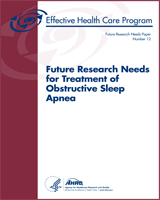NCBI Bookshelf. A service of the National Library of Medicine, National Institutes of Health.
Balk EM, Chung M, Chan JA, et al. Future Research Needs for Treatment of Obstructive Sleep Apnea: Identification of Future Research Needs From Comparative Effectiveness Review No. 32 [Internet]. Rockville (MD): Agency for Healthcare Research and Quality (US); 2012 Feb. (Future Research Needs Papers, No. 12.)

Future Research Needs for Treatment of Obstructive Sleep Apnea: Identification of Future Research Needs From Comparative Effectiveness Review No. 32 [Internet].
Show detailsContext
Comparative Effectiveness Reviews (CER)—systematic reviews of existing research on the effectiveness, comparative effectiveness, and comparative harms of different health care interventions—are intended to provide relevant evidence to inform real-world health care decisions for patients, providers, and policymakers. In addition to synthesizing the evidence, CERs also identify the gaps in evidence that limit the ability to answer the key research questions. As part of an effort beginning in 2010, the Agency for Healthcare Research and Quality supports its Evidence-based Practice Centers (EPCs) to work with various stakeholders to further develop and prioritize the future research needed by decisionmakers.2 This process is new, and the methods to delineate future research needs (FRN) are not yet fully developed. The current report describes the first experience of the Tufts EPC in a stakeholder-driven process to identify and nominate for prioritization FRN topics (other than a pilot process with a limited involvement of a small number of stakeholders).
The FRN document is intended to inform and support researchers and those who fund research to ultimately enhance the body of comparative effectiveness evidence so that it is useful for decisionmakers. This document describes the process of developing a prioritized list of research needs with considerations of the advantages and disadvantages of various potential research designs to help researchers and funders develop future research proposals or solicitations, respectively. This process begins with identification of evidence gaps from the original CER, followed by the addition of other areas potentially requiring further research, nomination for prioritization of these evidence gaps by stakeholders, and development of potential study designs for the highest priority topics. Although researchers and funders of research are the end-users of the report, the resulting research is meant to improve health care decisions; therefore, the stakeholders for this process include patients, clinicians, research investigators, payers, and policymakers.
The current FRN project was launched shortly after completion of the CER on obstructive sleep apnea (OSA). OSA is an important public health issue, due to the considerable mortality and morbidity associated with the condition. The commonly used methods for diagnosing and treating OSA are cumbersome, resource intensive, and often inconvenient for the patient. The Tufts EPC conducted a CER on diagnostic tools, characteristics of OSA that are predictive of poor outcomes, and treatments for OSA.1 For the purpose of the FRN process, the original OSA CER was divided into two overarching sections: diagnosis and treatment. This document describes the FRN for treatment of OSA; an accompanying parallel report describes the FRN for diagnosis.3 For the most part, the Background, Methods, and description of the challenges are nearly identical between the two reports.
Evidence Gaps
Figure 1 is an analytic framework to visualize areas of the systematic review in which evidence gaps were identified. Table 1 summarizes the evidence gaps identified in our review of the diagnosis of OSA in adults (the CER’s Key Questions 5–7). These gaps in the evidence review limited the ability to make conclusions on the questions asked; thus they formed the initial FRN topics.
Table 1
Evidence gaps affecting conclusions for the Key Questions.
- Background - Future Research Needs for Treatment of Obstructive Sleep ApneaBackground - Future Research Needs for Treatment of Obstructive Sleep Apnea
Your browsing activity is empty.
Activity recording is turned off.
See more...
